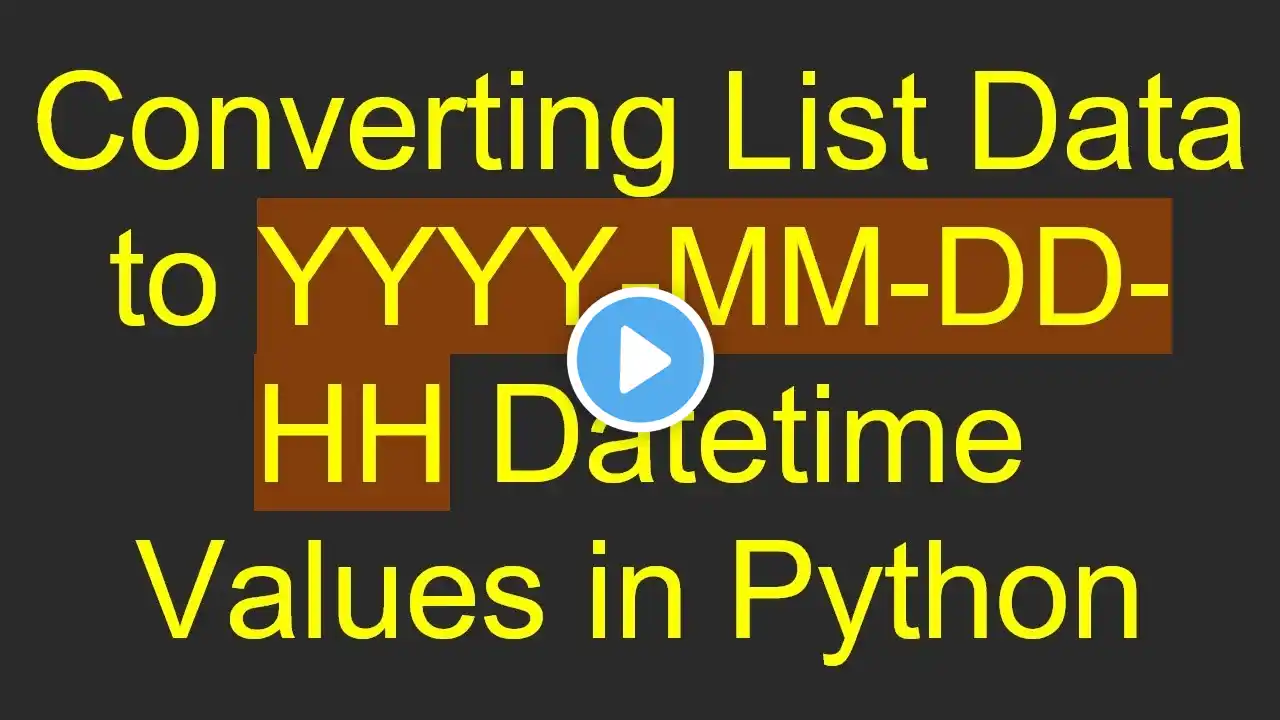
Converting List Data to YYYY-MM-DD-HH Datetime Values in Python
Discover how to convert your list of date strings into the `YYYY-MM-DD-HH` format using pandas in Python. Simplify date management and analysis with ease! --- This video is based on the question https://stackoverflow.com/q/70704662/ asked by the user 'Yousef Skandari' ( https://stackoverflow.com/u/17928778/ ) and on the answer https://stackoverflow.com/a/70705243/ provided by the user 'jjsantoso' ( https://stackoverflow.com/u/7087491/ ) at 'Stack Overflow' website. Thanks to these great users and Stackexchange community for their contributions. Visit these links for original content and any more details, such as alternate solutions, latest updates/developments on topic, comments, revision history etc. For example, the original title of the Question was: Changing data in a list into Datetime values Also, Content (except music) licensed under CC BY-SA https://meta.stackexchange.com/help/l... The original Question post is licensed under the 'CC BY-SA 4.0' ( https://creativecommons.org/licenses/... ) license, and the original Answer post is licensed under the 'CC BY-SA 4.0' ( https://creativecommons.org/licenses/... ) license. If anything seems off to you, please feel free to write me at vlogize [AT] gmail [DOT] com. --- Converting List Data to YYYY-MM-DD-HH Datetime Values in Python Managing date and time data is a common task in data analysis, especially when using Python's powerful pandas library. One question that many newcomers—especially those working with time-series data—often face is: How can I convert a series of date strings from my dataset into a specific datetime format, specifically YYYY-MM-DD-HH? In this guide, we'll dive into the solution, breaking down the process into clear steps, so you can handle this task confidently. Understanding the Data Let's consider the following sample data set representing dates and their corresponding values: [[See Video to Reveal this Text or Code Snippet]] As you can see, the dates are structured with the year, month, day, and hour, but they need to be reformatted for easier manipulation and understanding. Step 1: Determine the Data Type Before we can convert the date format, we need to check how the Date column is stored in your DataFrame. Is it stored as a string (object type) or a datetime type? You can check the type of the variable with the following pandas command: [[See Video to Reveal this Text or Code Snippet]] Step 2: Convert String Dates to Desired Format If the Date is a String (Object Type) If the Date column is of type object (string), you can easily manipulate it using the .str accessor provided by pandas. To achieve the desired YYYY-MM-DD-HH format, you can use the following code snippet: [[See Video to Reveal this Text or Code Snippet]] This code does the following: Extracts the year (first 4 characters). Extracts the month (5th and 6th characters). Extracts the day (7th and 8th characters). Extracts the hour (10th and 11th characters). If the Date is a Datetime Type If the Date column is already in datetime format, the conversion becomes even simpler. You can utilize the .dt accessor along with the strftime() function to format the datetime: [[See Video to Reveal this Text or Code Snippet]] This line changes the datetime to the specified string format directly! Conclusion No matter which initial format your dates are in, converting them to the YYYY-MM-DD-HH format is straightforward with pandas. Quick Recap: Check the data type of your Date column using df["Date"].dtype. For string types, use .str to slice the string into the desired format. For datetime types, use the .dt accessor along with strftime(). With these techniques, you'll enhance your ability to manage time-based data in Python effortlessly. Now you can focus on your analysis rather than being bogged down by date formatting issues!